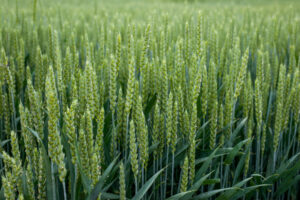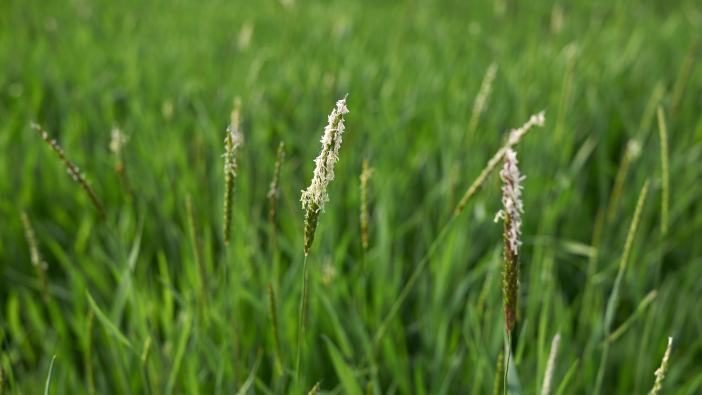Hutchinsons technical manager, Dick Neale, talks us through a series of actions growers can take in the spring, and beyond, to boost crop health
Dick kicked off proceedings by explaining that none of the ideas posited during the event should be considered in a vacuum. “Everything that we do, whether it is to tackle weeds, disease or nutrition, will have a knock-on effect that needs to be considered. We might apply nutrition for the benefit of the crop, but this will also have an impact on weed control.”
When looking at grassweeds, there was good news. Cultural controls had meant that despite a flush of blackgrass coming through with the increased moisture, there were significantly fewer plants/sq m this year. Dick noted that with the good ground conditions presently, growers should consider a third herbicide application in the autumn, rather than a spring application.
“In the west, there’s been some rain, so residuals are probably working quite well, but growers in the east are struggling. Putting on another autumn application will provide more residual protection and up to 20% efficacy, compared to 4-5% with a spring application and the possible knock-on effect to the yield,” Dick explains.
The additional herbicide application is to maintain levels of control of grassweeds. Looking again at blackgrass, Dick explained that while plants/sq m were down to under 50, and no more than 100 on bare ground ahead of the drill. “While plant numbers are down, the potential to go to head has increased. We’ve done such a good job at controlling it that we have created a beast in the surviving plants.”
He adds that growers need 90-95% control of blackgrass to keep populations where they are, so actions need to be carefully considered. We’ve reduced plant numbers to such an extent that with an integrated approach, including state seedbeds, delayed drilling, increased seed rates of competitive varieties and herbicides, it is possible to get populations down to just three plants/sq m.
For those tackling a serious grassweed problem, Dick says that they may have to establish a crop of spring barley to tackle this. “It might not be in your plans. It might not even be the most profitable option for you, but it will help suppress grassweeds.”

©Tim Scrivener Photographer
Cover crops and nutrition
Good working conditions, with a little bit of moisture in the ground, also give growers options to establish a cover crop. This will not only help with water management over the winter but also provide competition to any grassweeds present in the field.
Dick notes: “When establishing a cover crop, what’s happening under the ground is more important than what’s above ground. It might not look hugely impressive, but those rooting systems will be hugely beneficial to the following crop.”
Cover crops can also benefit nutrition levels in cash crops. In soils where phosphate is locked up, a buckwheat-dominant cover crop can solubilise this for the next crop. Phosphate was a priority during the event because it remains static within the soil, meaning that roots need to be encouraged early in the growth stages to seek it out.
“Growers will report phosphate soil indexes of more than 3, and yet plants will show a deficit,” he says. “This means that the crop is not accessing the nutrients. A placed starter fertiliser can be helpful here, with a small amount of phosphate helping roots develop enough to absorb what is present in the soil.
“Keeping the roots moving means that nutrients are absorbed more easily, and it can stop the plant from dumping tillers because it recognises a deficit somewhere, or during periods of high stress.”
He highlighted Primary-P and Crystal Green as good solutions for this, but said that Triple Super Phosphate (TSP) would slow germination when placed in contact with the seed. “It’s okay with precision planters, where it’s placed to the side of the seed.”
Looking at nitrogen, he explains that many growers are probably putting around 25kg/ha too much on their crops. “There is an economic peak that we’ve found through trial work, which is around 200kg/ha. More than this, the yield benefits often do not cover the additional cost; not only that, but you’re not just feeding the crop, you’re feeding the lodging potential, disease and weed pressure, which means you’ll be spending more on inputs.”
The timing of nitrogen had to be carefully planned, as too much too early would promote growth in the wrong areas of the plant. Similarly, while crops would yield well on less than 200kg/ha, less than around 150kg could have a significant impact on yield.

Seed rates and blends
While possibly too late for some growers, there were a lot of interesting details on how changing drill choice will affect seed rates. Dick explains that the shift to wider drills with 20cm row spacings does not mean that the seed rate should be increased exponentially.
“Disc drills will create a row that is just 2-3cm wide, compared to 3-4cm with band sowing, and the wider row spacing means that a much smaller proportion of the field is being worked. If you keep pushing seed rates up, then you’ll choke the crop, forcing it to grow straight up instead of pushing outwards,” he says.
“The Omnia system takes this into account and will provide the correct seed rate based on row spacing and the desired plants/sq m, and it will do this for fertiliser placement as well, because the concentration of fertiliser increases significantly in these narrow rows.”
He also encouraged farmers to consider blends, citing the work done in Denmark, where the top three wheat varieties are blended, making up 50% of the total market over there. He explains that blends are not going to boost yields – indeed, he says that if a blend contains the highest yielding variety in your area, there is a chance that that single variety would outperform the blend, but that in 75% of cases the blend would beat out any single variety.
“You can use blends in wheat, barley and oilseed rape, and it will provide protection against the different pressures,” he says. “It provides more competition above and below the ground, and varieties that are at risk from pests or disease will benefit from having resistant varieties around them.”
To highlight this, he pointed to the YR15 strain of yellow rust, a strain so aggressive that Dick believes it should be categorised as a new disease. “A lot of growers will have little choice but to sow varieties that have fallen victim to this again, and a blend could limit the damage of YR15. If you have a four-way blend, you might lose 25% of the crop, instead of a significant yield impact across the whole field.
“There’s also no need to worry about timing differences across the blend,” he concludes. “These crops are constantly signalling to each other through their rooting systems and should come to each growth stage together.”


